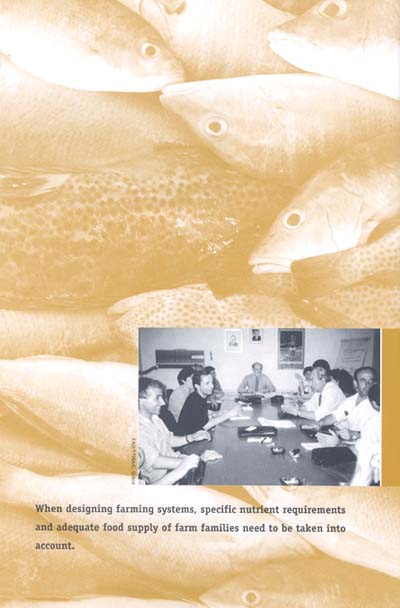
These Guidelines offer suggestions which can be adapted to meet an individual country's specific needs. It is assumed that further development and adaptation of these Guidelines within each country will provide a window of opportunity for agricultural researchers and other stakeholders to open discussions on mechanisms for including nutrition in the national research agenda, with the ultimate goal of improving the food security and nutritional status of vulnerable rural communities. Vulnerable rural communities in this case refers to groups that are susceptible to food insecurity and undernutrition caused by a variety of difficulties, including poverty, compromised or unbalanced diets, natural and human-made disasters, debilitating diseases such as HIV/AIDS, and the effect of low social status.
Objectives
The Guidelines are designed to assist stakeholders at all levels. The following list presents the general objectives for all disciplines addressed in this document.
Identify approaches and mechanisms that will ensure that the nutritional needs of small resource-poor farm families (usually the majority) are taken into account during the planning, formulation and execution of agricultural research at national and international levels.
Elaborate upon ways the incorporation of nutrition issues into agricultural research can affect overall production systems and their income generating capacity.
Develop a framework that will assist agricultural research and extension services in incorporating nutrition issues into the planning and execution of their activities.
Assist research and extension workers in linking some of their specific objectives to the alleviation of malnutrition, particularly of the rural poor.
Encourage countries to adopt and/or strengthen multidisciplinary and intersectoral approaches when formulating their agricultural policies, research programmes and in the implementation of research and extension service activities.
Identify gender-related issues and ensure that they are considered when planning and implementing agricultural research projects.
Encourage participation of the ultimate beneficiaries, i.e. the farm families and farm labourers, in the planning and implementation of project activities in order to promote national capacity-building and sustainability.
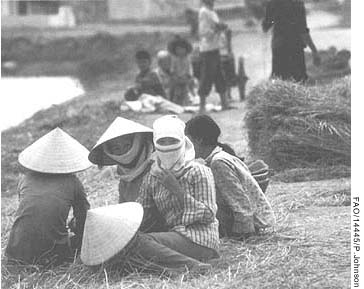
The Guidelines will assist agricultural research to improve the food security and nutritional status of vulnerable rural communities.
Integrating nutrition concepts into agricultural research
The Guidelines recommend several strategies aimed at consolidating efforts to improve the household food security and nutritional status of subsistence farming communities. These strategies, that can be implemented throughout the development process, include: using participatory approaches that involve stake-holders in the planning, implementation and evaluation of research projects and programmes; developing institutional linkages and frameworks that can facilitate collaboration among the main actors: including gender considerations in project design and implementation: involving stakeholders in the planning and implementation of agricultural activities; developing food production techniques tailored for small resource poor farmers; and providing continued information dissemination to keep all actors informed and training to keep them up-to-date on technological developments.
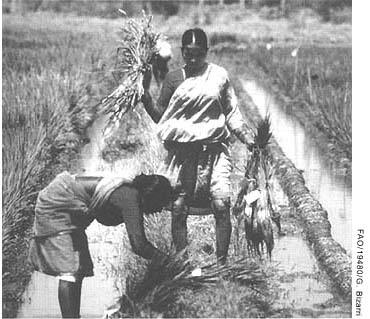
Gender considerations need to be included in project design and implementation.
When introducing nutrition into the research agenda, the nutritional situations of countries and communities will vary. Thus, it is necessary to recognize that while there are certainly important agronomic factors involved, there are also other factors such as gender issues, choice of approaches, policy directions and institutional linkages to be considered. The following lists offer some suggestions within each of these areas.
AGRONOMIC FACTORS
Design farming systems with sufficient variety in the crop mix to provide a balanced diet and meet the nutrient requirements (energy, protein, vitamins and mineral salts) of the target group, which includes resource-poor, small farmers and their communities. Strategies such as food crop diversification, cultivation of indigenous plants, development of vegetable gardens and fruit crops, rearing of small livestock, development of backyard fish ponds, and agroforestry can be employed to increase the food base and supplement staple foods. Access by farmers to coordinated advice on nutrition and production-related issues is essential at this point.
Consider nutritional needs of local people, seasonal availability of food, level of development, the economic situation (cost of farm inputs and labour demands), and the environment, when developing production systems and technologies for subsistence farmers. The level of technology to a large extent determines the quantity of food that can be produced at a given cost. In addition, application of advanced food production technologies often can reduce fluctuations in seasonal food availability, food prices and income.
Consider intra-household factors which influence the behaviour of resource-poor farmers in relation to commodity prices when giving advice to farmers on marketing strategies. For example, subsistence farmers often are forced sell their farm produce when prices are low to obtain cash income for family use, and later must purchase the same commodity at a higher price for family consumption.
Strengthen post-harvest research. Inadequate post-harvest technologies and practices contribute to unnecessary nutrient and physical food losses.
GENDER-RELATED CONSIDERATIONS
Recognize the enormous productive role of women in agriculture, especially in food production. Women's contributions to food production are most evident in the labour they provide in planting, crop management (e.g. weeding, stalking), post-harvest activities, processing, storage and marketing. About 50 percent of food crops in Asia are produced by women (FAO 1988). In many parts of Africa, women provide about 60 percent of the agricultural labour force and up to 80 percent of total food production labour force. In addition, women in many developing countries are responsible for producing food consumed by their families.
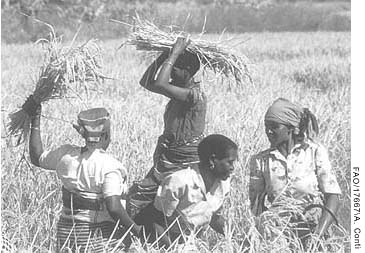
Women have an enormous productive role in agriculture, especially in food production.
Acknowledge and promote the importance of food crops that are normally grown by women. The focus of research and extension on male-dominated cash crops sometimes marginalizes women's work. Crops such as groundnuts, cowpeas and other vegetables and fruit that are commonly grown by women need to be promoted. Such crops, especially vegetables, are normally consumed by household members and therefore, should be considered, first, as important sources of food and valuable nutrients and only second as sources of income.
Include women's agricultural activities in extension programmes. This is an important consideration for extension services in particular. Although participation of women in development issues has been encouraged and, indeed, has been increasing since International Women's Year was declared in 1975, women's production activities still are not covered adequately by extension services. Yet studies show that extension is cost effective and has a significant impact on farmers' knowledge and successful adoption of new technologies, resulting in increased productivity and rural incomes. This in turn impacts positively on household food security and nutritional status. FAO estimates that women receive only about one-twentieth (5 percent) of the extension services received by men (FAO, 1998).
Involve women in Participatory Rural Appraisals (PRA) at the village level, to ensure that their needs and concerns are considered in any planning, and that adoption of technologies does not become a burden to them. It is important to remember that new technologies and agricultural projects could have a negative impact on family nutritional status if, for example, they make greater demands on women's time, taking them away from their family care activities.
Recognize that good nutritional status is not only dependent on household food security, it requires good health and physical and mental well-being. Good health helps ensure the body's efficient utilization of the food consumed. Additionally, care and nurturing play an important role in nutritional status, particularly in relation to young children.
INTEGRATED PARTICIPATORY APPROACHES
The importance of adopting integrated participatory approaches to agricultural and rural development is well recognized. Good nutritional status is an essential goal of the development process and can only be realized and sustained if integrated into the mainstream development sectors and if participation of all the stakeholders is ensured. Since the majority of food insecure and nutritionally vulnerable rural communities derive their livelihoods from farming, it is most appropriate to integrate nutrition considerations into the agricultural research agenda.
The farming systems research approach, participatory rural appraisal (PRA), research-extension-farmer linkages, participatory extension, and such concepts as client-oriented, demand-driven research are all committed to the process of involving major stakeholders (farmers, policy-makers, researchers, extensionists) in the planning and implementation of agricultural research. By involving stake-holders, it becomes possible to take a holistic approach to farmers' needs and to include their nutritional requirements in the planning and implementation of agricultural research programmes. PRA can be used to identify the basic needs, eating habits and appropriate cropping systems of various communities, as well as to gather information on problems and constraints related to environmental degradation and crop-livestock production systems (Shao, 1997).
The main focus of these Guidelines is resource-poor farmers and low income rural families who derive their livelihoods from agriculture, either as subsistence farmers or as farm labourers. These rural people do not have the authority or confidence to to coerce the research system to address their needs; their access to research information is limited; and because they are risk averse, their adoption of new technologies is extremelow or non existent. Therefore, a major challenge facing agricultural research institutions is ensuring effective interaction among researchers, extension workers, trainers and resource-poor farmers. PRA or the farming systems research approach, which use multidisciplinary research teams and extension agents, can be used to identify nutritional and agronomic concerns of this target group. This information can then be incorporated into research policies and priorities, and utilized when planning and implementing research projects. Deliberate efforts to ensure effective interaction among researchers, extension agents and resource poor farmers is essential.
Due to changing environmental conditions, living patterns and nutritional requirements, there is need for ongoing research into the cultivation and processing of local foods, as well as regular dissemination of information on food requirements. This calls for an integrated approach to planning and executing research projects. Research has not always been able to fulfil this need, largely because the objectives and priorities of research institutions are sometimes determined by external donor funding. Further, research institutions rarely have the nutrition and food technology expertise to provide the necessary advice and skills. Introducing and/or strengthening post-harvest units in research centres, including nutrition in post-harvest activities, and providing physical facilities for their work can help ensure an integrated, multidisciplinary approach.
POLICY CONSIDERATIONS
Among all development sectors, agriculture has the greatest role to play in improving the food and nutrition situation of vulnerable rural communities. Presently, the challenge for agricultural research is to adapt or develop effective technologies suitable for resource poor farmers, in order to help improve their food and nutrition situations. It is important, therefore, to develop policies that support research programmes in addressing the food security situation of the poor and undernourished. Although such policies should be developed at both national and international levels, the national level is more strategic since concerns and problems of resource poor farmers can be addressed most effectively and efficiently at the grassroots level.
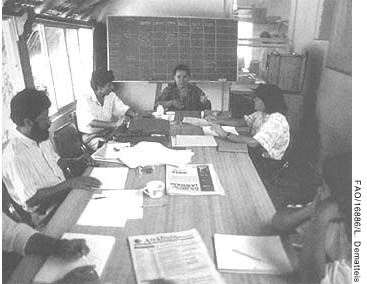
An integrated nutrition policy needs to be developed by an intersectoral group.
However, it must be noted that the policy of the agriculture sector alone cannot successfully promote and support sustainable strategies and programmes to improve nutritional status. Policies in related sectors and disciplines with direct impacts on nutrition, such as health, education, environment, rural development, poverty reduction and gender, also should be addressed to exploit the synergy. Ideally, a holistic, integrated approach should be employed by those developing policies. In practice, the development and coordination of a holistic nutrition policy could be done through nutrition coordinating bodies or similar intersectoral structures.
INSTITUTIONAL LINKAGES
Nutrition should be a concern of all development sectors, because nutritional status depends upon a combination of socio-economic, health and politically related factors. Thus collaboration and cooperation among the responsible sectors is imperative to improve nutritional status and ensure that the improved status is sustainable. However, in practice, collaboration among the different sectors is often hindered by the parallel sectoral administrative arrangements in many countries. Commonly, sectors that carry out nutrition-related activities are agriculture, health, rural development and education. It is mainly among these sectors that linkages should be aggressively fostered to enhance nutritional status. However, NGOs should also be involved, because they have potential to be strong collaborators. Since there is a move towards privatization in many developing countries, the private sector is also an important collaborator.
A mechanism for fostering linkages and coordinating nutrition-related activities of the different sectors could be established by a multisectoral body such as a national nutrition council. The leadership of this body could be in the planning ministry, with the primary roles of coordinating national level activities relating to nutrition and advising governmental bodies on nutrition policy.
As mentioned above, under “Integrated Participatory Approaches”, one of the most feasible and practical ways to incorporate nutrition considerations into research plans and programmes is to include nutrition as a component of post-harvest research in agricultural research institutions. The key to its success is to ensure that post-harvest research is demand driven and consumer focused. Since nutrition-related activities ideally should be incorporated into the development process, it is necessary to develop linkages between research and development agencies that can promote effective communication of research results to the intended clients, which are mainly rural families.
A major function of the extension service is to provide farmers with information on all aspects of production, processing, utilization and nutrition, as well as to foster linkages among farming communities, service providers, extension workers and consumers. However, a general limitation of the extension service in developing countries is that the ratio of extension workers to farmers is very low, limiting the coverage of extension services. Resources at the disposal of extension services are limited as well. And, because information, technology and services are not always tailored for small, resource-poor farmers, extension intervention is necessary to ensure that these farmers are given the specific types of attention and assistance they need.
In order to enhance their effectiveness and efficiency, extension programmes need to be strategically planned, needs-based (including nutritional needs) and strongly participatory, with a bottom-up, problem-solving orientation. For agricultural research programmes to support small resource poor farmers adequately, all stakeholders, namely policy-makers, researchers, extension officers, farmers and consumers, should participate in the development and implementation of research projects and programmes. The extension service potentially plays the crucial role of mediator between research institutions and farmers regarding issues of production, processing and utilization. The involvement of extension services in incorporating nutrition into agricultural research plans and programmes is therefore, crucial.